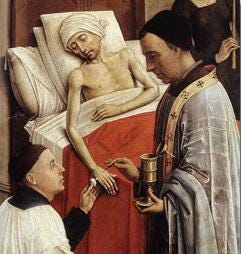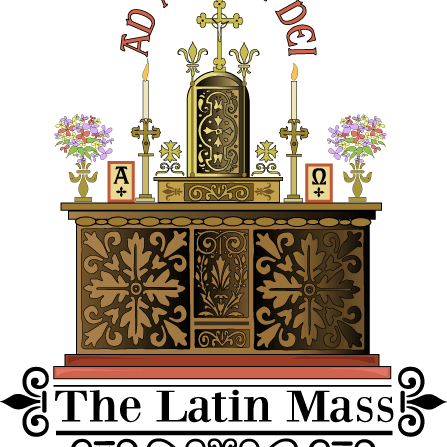This column was meant to go out last week, but for some reason, I couldn’t access my Substack login, so you’ll be getting two columns this week, so stay tuned for the second later one.
When Catholics think of the Church’s ministry to the sick, the Anointing is often the first and perhaps only thing that comes to mind, but that is merely one aspect of the many rites the Church provides. Nevertheless, let’s consider it first, and then we’ll move on to the other rites.
The 1948 edition of the Roman Ritual contains a theological commentary on the Anointing of the Sick or Extreme Unction, and even then, it decried the reduction of the Sacrament to the priest racing to the bedside of the person at death’s door with only time to give the most basic form of the Sacrament before the person expires. While there are always accidents, sudden seizures, and the like, which make the full rite impossible, in most cases, it is simply the delay on the part of the patient or the family that causes such a rush.
The full rite is beautiful and dignified, as are all of the Church’s traditional rites, and it is meant to impart consolation not just through the effects of the Sacrament but by the accompanying prayers and ministrations.
While the term “Extreme Unction” has a certain finality to it (hence the change in terminology after the Second Vatican Council), it is not to be seen as a last resort when everything else fails. It is not, for example, a substitute for the Sacrament of Penance. Rather, it is a compliment, as Penance is normally a prerequisite for the Anointing.
Penance can heal us of our sins, but the wounds of sin remain. Whereas the Anointing wipes away all scars of sin and heals the soul so perfectly that St. Thomas conceived of it as an immediate anointing for heavenly glory.
This last anointing also has a strong connection to the Sacraments of Initiation, especially Baptism and Confirmation, which each have their own anointings. In Baptism, the soul participates in the triumphant death and resurrection of Christ and receives for the first time the consecration of the Holy Ghost. Confirmation furthers the Holy Ghost’s indwelling.
In Extreme Unction, the oil signifies our Lord’s coming with the Holy Ghost, Who will soothe, heal, console, strengthen, and consecrate one who has been constituted a living temple of God. The Anointing is an anointing unto perfection, which restores the integrity of Baptism and brings the Christian into full harmony, unity, and life with the Church and her Spouse.
Regarding this Sacrament, the Council of Trent states:
For the thing signified is the grace of the Holy Spirit, Whose anointing blots out sins if any remain to be expiated, and also the remains of sin, and raises up and strengthens the soul of the sick person by exciting in him great confidence in the divine mercy, sustained by which he bears more lightly the troubles and pains of his illness, and resists more easily temptations of the devil who lies in wait for his heel; and sometimes when expedient for the welfare of his soul restores bodily health.
Now there is a trend today which goes to the opposite extreme, which states that everyone is “sick in some way,” and so everyone is a subject for the Anointing. The rite specifies that it is to be given to those in periculo mortis due to illness or old age. However, the Church is so generous that even if there is some doubt about the seriousness of a particular illness, the Anointing can still be administered conditionally. So while everyone is not a genuine subject for this Sacrament, if there is even the slightest indication of potential danger, the Sacrament can be properly administered.
In addition to the Anointing, the faithful are bound by precept to receive Holy Communion when in danger of death from any cause.
You have no doubt heard me explain that Holy Communion can be received licitly twice in one day, but according to the law, the second instance must be at a Mass. In the case of one in danger of death, we throw that law out, and Holy Viaticum can be received outside of Mass, even if the person has already communicated that same day. Communion can be received as Viaticum daily, if danger of death persists.
Of course, if one is homebound due to illness and cannot attend Mass in the church, Holy Communion can also be brought.
The Roman Ritual also provides prayers for ‘Visitation and Care of the Sick.’ This rite is used when a priest makes a first visit to a sick person to either assess the condition of the person and discern whether they need the Anointing or Holy Viaticum or if the person is simply not yet properly disposed to receive these Sacraments.
Turning to ministrations for the dying, the first Rite that the Church provides is the Apostolic Blessing with Plenary Indulgence. The ritual notes that it should be imparted following the Sacraments of Anointing and Viaticum, ideally while the sick person is still rational and conscious, but can still be granted to anyone who would have desired it, as long as they were not impenitent or excommunicated.
Again, so generous is the Church that if a priest is unavailable:
Holy Mother Church benevolently grants to the Christian faithful, who are duly disposed, a plenary indulgence to be acquired at the point of death, provided they have been in the habit of reciting some prayers during their lifetime; in such case, the Church supplies for the three conditions ordinarily required for a plenary indulgence.
In other words, confession, communion, and prayer for the Pope are not required.
The faithful can obtain this plenary indulgence at the hour of death, even if they have already acquired a plenary indulgence on that same day.
Finally, the Church also provides the Rite of Commending a Departing Soul Unto God. This is simply a long list of prayers, litanies, and scriptures passages that the priest can pray for and with someone who is in their final hours or minutes to offer comfort and hope to the dying person and those around them. This rite concludes with prayers to be said at “The Soul’s Departure,” in other words, at the moment of death.
So what’s the takeaway from all of this? First, it’s my hope that this clarifies to some degree the timing of the various rites. Extreme Unction, despite its rather final-sounding name, should not be reserved for the last moments of life but is intended for the onset of serious illness. Likewise, Holy Viaticum is not reserved for the end but can be given whenever there is any danger of death.
I also want to make clear that asking me to come and administer ANY of these rites is not an imposition on my time. Yes, priests are busy, but ministering to the sick and dying is one of the most important parts of a priest’s job, so do not be concerned about asking.
Finally, if you need me to come and administer any of these rites, please let me know the severity of the situation. If you need me to drop everything and come as soon as humanly possible, tell me that. Most of the time, I can accommodate that, though if I am at a meeting in Hamilton, for example, that may not be possible, in which case there are priests on call for the hospital. Nevertheless, please don’t downplay anything because you’re afraid of imposing on my time.




